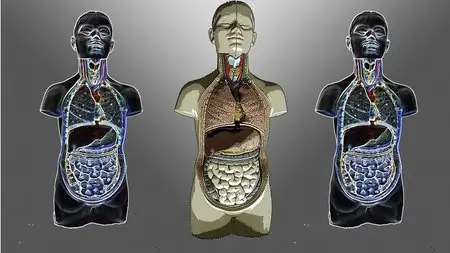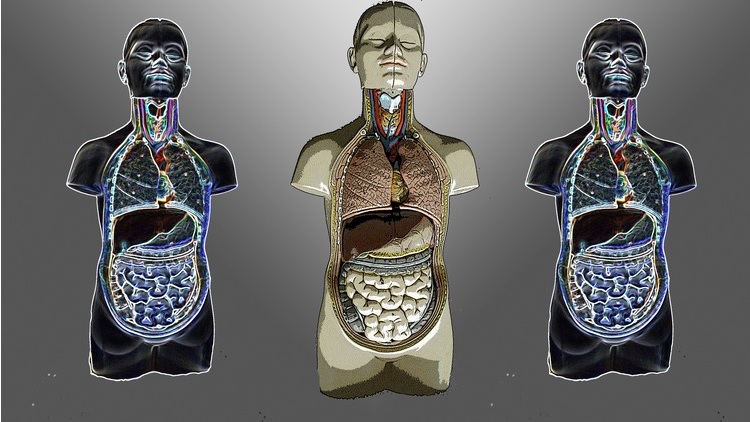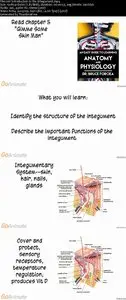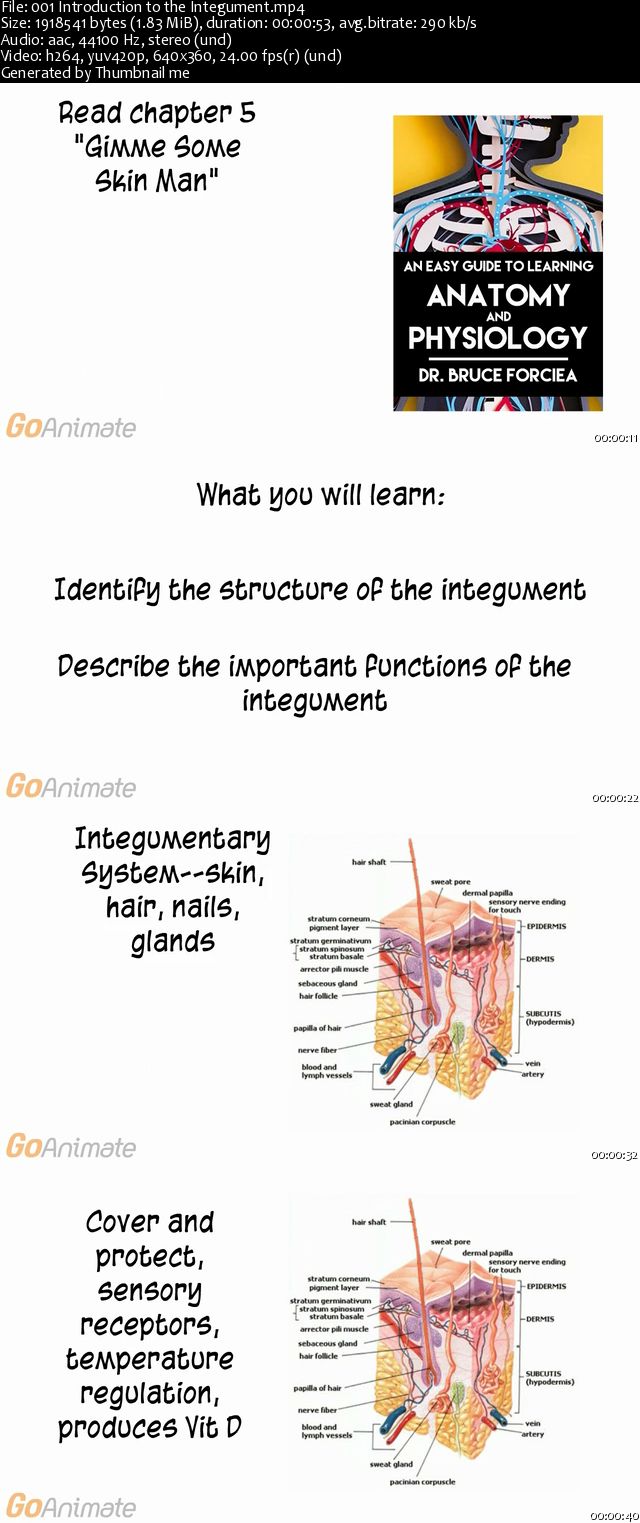Easy Anatomy and Physiology (Platinum Edition)
WEBRip | MP4/AVC, ~427 kb/s | 1280 x 720 | English: AAC, 87.3 kb/s (2 ch), 44.1 KHz | 1.23 GB
Genre: Academics / Math & Science | Language: English | +Project Files
WEBRip | MP4/AVC, ~427 kb/s | 1280 x 720 | English: AAC, 87.3 kb/s (2 ch), 44.1 KHz | 1.23 GB
Genre: Academics / Math & Science | Language: English | +Project Files
An Easy Guide to Learning the Anatomy and Physiology of the Human Body
This course presents many of the topics found in a typical 2-semester college anatomy and physiology course.
The topics are presented through animated videos and an ebook (An Easy Guide to Learning Anatomy and Physiology). Each body system is presented separately and there are quizzes at the end of each section. The typical time to complete this course is from about 8 - 12 weeks.
Anyone wishing to learn about the anatomy and physiology of the human body will find this course useful, particularly students in allied health programs such as nursing, physical therapy, pre-chiropractic, and pre-medicine.
High school students taking A&P should find this course helpful as well.
This course is useful as a stand alone course or for supporting existing A&P courses. It also serves as a great review of A&P.
What are the requirements?
- High school reading level.
What am I going to get from this course?
- Over 109 lectures and 10.5 hours of content!
- Identify anatomical structures of the human body
- Understand anatomical terminology
- Understand the physiology of human body systems
What is the target audience?
- This course will benefit allied health program students (nursing, physical therapy, pre-medicine, pre-chiropractic, and other health programs). This course will also benefit high school biology/anatomy and physiology students and those wishing to review human anatomy and physiology.
Curriculum
Section 1: Unit 1: Introduction to Human Anatomy
Lecture 1 Course Introduction 04:49
How to work through this course and an overview of the human body.
Lecture 2 Introduction to the Human Body: Notes 10 pages
Read these notes from An Easy Guide to Learning Anatomy and Physiology, Chapter 1.
Lecture 3 Anatomical Terms, Planes, and Abdominal Divisions 05:22
Covers anatomical terms, planes and abdominal divisions.
Lecture 4 Body Cavities 01:03
Identify the main body cavities.
Lecture 5 Homeostasis and Feedback Mechanisms 02:26
Describe the concept of homeostasis and feedback mechanisms.
Quiz 1 Unit 1 (Introduction to the Human Body) Quiz 22 questions
Section 2: Cells
Lecture 6 Introduction to Cells 01:55
How to work through this section of the course.
Lecture 7 Cells Unit: Notes 24 pages
Read these notes from Chapter 2: An Easy Guide to Learning Anatomy and Physiology
Lecture 8 Cell Organelles 03:52
Lecture 9 Structure of DNA and RNA 02:58
Lecture 10 Cell Transport Mechanisms 06:10
Quiz 2 Cells Quiz 11 questions
Section 3: Cell Metabolism
Lecture 11 Introduction to Cell Metabolism 00:51
How to work through this section of the course.
Lecture 12 Cell Metabolism: Notes 15 pages
Read these notes from Chapter 3: An Easy Guide to Learning Anatomy and Physiology
Lecture 13 ATP-Phosphocreatine System 02:04
Identify the ATP-Phosphocreatine system, an anerobic system for making ATP.
Lecture 14 Introduction to Glycolysis 01:15
Describe a basic overview of glycolysis.
Lecture 15 Glycolysis in More Detail 01:30
Describe glycolysis in more detail.
Lecture 16 The Krebs (Citric Acid) Cycle 01:51
Describe the Krebs (Citric Acid) cycle.
Lecture 17 Overview of The Electron Transport Chain 02:34
Describe the basic process of the electron transport chain.
Lecture 18 The Electron Transport Chain in More Detail 02:15
Describe a more detailed version of the electron transport chain.
Quiz 3 Cell Metabolism Quiz 16 questions
Section 4: Human Body Tissues
Lecture 19 Introduction to Human Body Tissues 00:59
Lecture 20 Tissues: Notes 8 pages
Read these notes from Chapter 4: An Easy Guide to Learning Anatomy and Physiology
Lecture 21 Epithelial Tissue 03:25
Identify the structure and function of epithelial tissue.
Lecture 22 Connective Tissue 04:28
Identify the structure and function of connective tissue.
Lecture 23 Muscle Tissue 03:22
Identify the structure and function of muscle tissue.
Lecture 24 Nervous Tissue 01:43
Identify the structure and function of nervous tissue.
Quiz 4 Tissues Quiz 22 questions
Section 5: The Integument
Lecture 25 Introduction to the Integument 00:53
Lecture 26 The Integument: Notes 8 pages
Read these notes from Chapter 5: An Easy Guide to Learning Anatomy and Physiology
Lecture 27 The Integument 06:37
Describe the structure and function of the integument.
Quiz 5 Integument Quiz 10 questions
Section 6: The Skeletal System
Lecture 28 Introduction to the Skeletal System 00:46
Work through the skeletal system unit.
Lecture 29 Skeletal System: Notes 41 pages
Read these notes from Chapter 6: An Easy Guide to Learning Anatomy and Physiology
Lecture 30 Endochondral Ossification 02:07
Describe the process for long bone formation.
Lecture 31 Intramembranous Ossification 01:55
Describe how flat bones are formed.
Lecture 32 The Skull 05:43
Identify the structure of the skull.
Lecture 33 The Spine and Ribcage 05:01
Identify the structure of the spine and ribcage.
Lecture 34 The Shoulder, Arm and Hand 03:35
Identify the structure of the bones of the shoulder, arm and hand.
Lecture 35 The Lower Extremity 05:10
Identify the bony structures of the lower extremity (hip, leg, foot).
Quiz 6 Skeletal System Quiz 41 questions
Section 7: The Muscular System
Lecture 36 Introduction to the Muscular System 00:48
Overview of the muscular system.
Lecture 37 Muscular System: Notes 42 pages
Read these muscular system notes from: An Easy Guide to Learning Anatomy and Physiology.
Lecture 38 Types of Muscle Contractions 04:04
Describe muscle terms and types of contractions.
Lecture 39 Muscle Anatomy 07:56
Identify major muscles of the human body.
Quiz 7 Muscular System Quiz 1 18 questions
Lecture 40 Muscle Contraction Physiology 03:40
Describe the physiology of muscle contraction.
Quiz 8 Muscular System Quiz 2 8 questions
Section 8: Joints
Lecture 41 Introduction to Joints 00:37
Overview of joints.
Lecture 42 Joints: Notes 11 pages
Read these notes from: An Easy Guide to Learning Anatomy and Physiology
Lecture 43 Joints 05:25
Joint classification and basic anatomy of joints.
Quiz 9 Joints Quiz 10 questions
Section 9: The Nervous System
Lecture 44 Introduction to the Nervous System 00:47
Overview of the nervous system.
Lecture 45 Nervous System Notes 28 pages
Read these notes from: An Easy Guide to Learning Anatomy and Physiology
Lecture 46 The Brain 06:52
Anatomical structures of the human brain.
Lecture 47 Spinal Cord Anatomy 04:56
Identify the anatomy of the spinal cord.
Lecture 48 The Spinal Nerve 02:52
Identify the anatomy of the spinal nerve.
Lecture 49 Reflexes 02:42
Describe how reflexes work.
Quiz 10 Nervous System Quiz 1 20 questions
Lecture 50 The Cranial Nerves 05:40
Quiz 11 Cranial Nerve Quiz 10 questions
Lecture 51 Resting Membrane Potential 02:42
Identify the processes involved in producing the resting membrane potential in a neuron.
Lecture 52 Generation of an Action Potential 03:08
Describe how neuron action potentials are generated.
Lecture 53 Saltatory Conduction 03:11
Identify the process of saltatory conduction that occurs in myelinated axons.
Quiz 12 Neuron Quiz 10 questions
Section 10: The Sensory System
Lecture 54 Introduction to the Sensory System 00:47
Overview of the sensory system.
Lecture 55 Sensory System Notes 14 pages
Read these sensory system notes from: An Easy Guide to Learning Anatomy and Physiology
Lecture 56 The Somatosensory System 04:24
Describe the structure and function of the somatic senses.
Lecture 57 Special Senses: Smell and Taste 03:01
Describe the structure and function of the special senses of smell and taste.
Quiz 13 Sensory System Quiz 1 11 questions
Lecture 58 Special Senses: The Ear 05:33
Identify anatomical structures and describe the function of the ear.
Lecture 59 Special Senses: The Eye 04:57
Identify anatomical structures and describe the function of the eye.
Quiz 14 Sensory System Quiz 2 17 questions
Section 11: The Endocrine System
Lecture 60 Introduction to the Endocrine System 00:55
Overview of the endocrine system
Lecture 61 Endocrine System: Notes 16 pages
Read these notes from: An Easy Guide to Learning Anatomy and Physiology
Lecture 62 Types of Hormones 03:04
Identify different types of hormones.
Lecture 63 Growth Hormone and Thyroid Hormones 05:13
Describe the function of growth hormone and thyroid stimulating hormone.
Lecture 64 Adrenocorticotropin Hormone 02:21
Describe the function of ACTH.
Lecture 65 Follicle Stimulating and Luteinizing Hormones 02:48
Describe the function of FSH and LH.
Quiz 15 Endocrine System Quiz 1 12 questions
Lecture 66 Posterior Pituitary Hormones 01:44
Identify and describe the function of the posterior pituitary hormones.
Lecture 67 Insulin and Glucagon 02:08
Describe the functions of insulin and glucagon.
Lecture 68 Calcitonin and Parathyroid Hormone 02:06
Describe the functions of calcitonin and PTH.
Quiz 16 Endocrine System Quiz 2 10 questions
Section 12: The Blood
Lecture 69 Introduction to the Blood 00:55
Overview of the blood.
Lecture 70 Blood: Notes 9 pages
Read these notes from: An Easy Guide to Learning Anatomy and Physiology
Lecture 71 The Blood 04:44
Identify the parts of blood and their functions.
Lecture 72 Blood Typing 04:42
Identify the different blood types.
Quiz 17 Blood Quiz 10 questions
Section 13: The Cardiovascular System
Lecture 73 Introduction to the Cardiovascular System 01:06
Lecture 74 Cardiovascular System: Notes 23 pages
Read these cardiovascular system notes from: An Easy Guide to Learning Anatomy and Physiology
Lecture 75 Anatomy of the Heart 05:51
Identify heart structures.
Lecture 76 Circulatory System Anatomy 05:47
Identify major blood vessels.
Quiz 18 Cardiovascular Quiz 1 15 questions
Lecture 77 Atrial Natriuretic Peptide 02:15
Describe the function of ANP for blood pressure control.
Lecture 78 The Cardiac Control Center 03:42
Identify the cardiac control center and describe its function.
Lecture 79 Cardiac Output 05:18
Describe how cardiac output and Starling's Law of the Heart function.
Lecture 80 The Electrocardiogram (ECG) 03:58
Identify the major parts of an ECG.
Quiz 19 Cardiovascular System Quiz 2 21 questions
Section 14: The Lymphatic System
Lecture 81 Lymphatic System Notes 7 pages
Read these Lymphatic System notes from: An Easy Guide to Learning Anatomy and Physiology
Lecture 82 The Lymphatic System 03:27
Describe the structure and function of the lymphatic system.
Quiz 20 Lymphatic System Quiz 7 questions
Section 15: The Respiratory System
Lecture 83 Introduction to the Respiratory System 01:04
Lecture 84 Respiratory System Notes 15 pages
Read these respiratory system notes from: An Easy Guide to Learning Anatomy and Physiology
Lecture 85 Respiratory System Anatomy 05:08
Identify the anatomy of the respiratory system.
Quiz 21 Respiratory System Quiz 1 12 questions
Lecture 86 Breathing Mechanics 03:52
Describe how inhalation and exhalation function.
Lecture 87 Neural Control of Breathing 03:44
Describe how the nervous system controls breathing.
Lecture 88 Surface Tension 02:41
Describe how surface tension affects the lungs and the role of surfactant.
Quiz 22 Respiratory Quiz 2 15 questions
Lecture 89 Gas Exchange 06:54
Describe how oxygen and carbon dioxide are exchanged between the lungs, blood and tissues.
Lecture 90 Carbon Dioxide Transport 03:46
Describe how carbon dioxide is transported in the blood.
Lecture 91 Lung Volumes 05:50
Identify the lung volumes and capacities.
Quiz 23 Respiratory Quiz 3 15 questions
Section 16: The Urinary System
Lecture 92 Introduction to the Urinary System 00:44
Overview of the urinary system.
Lecture 93 Urinary System Notes 20 pages
Lecture 94 Urinary System Anatomy 04:25
Identify anatomical structures of the urinary system.
Lecture 95 Glomerular Filtration 05:28
Describe the process of glomerular filtration in urine formation.
Quiz 24 Urinary System Quiz 1 14 questions
Lecture 96 Juxtaglomerular Apparatus 03:32
Describe the function of the juxtaglomerular apparatus.
Lecture 97 Renin-Angiotensin System 03:07
Describe the physiology of the renin-angiotensin system.
Lecture 98 The Nephron Loop 04:30
Describe the physiology of the nephron loop.
Lecture 99 Antidiuretic Hormone 02:06
Describe how antidiuretic hormone affects the nephron.
Lecture 100 Tubular Reabsorption and Secretion 05:07
Describe the processes of tubular reabsorption and secretion.
Quiz 25 Urinary System Quiz 2 20 questions
Section 17: The Digestive System
Quiz 26 Digestive System Quiz 25 questions
Section 18: The Reproductive System
Quiz 27 Reproductive System Quiz 20 questions
LabView - Collective Books
Mega E-books Pack (2013)
Malware Centric E-book Collection
Huge Electricity, Magnetism, A..., Healing - EBooks Collection
Premium IT eBooks Collection
Huge Encyclopedias - EBooks Collection
Osprey Publishing - Military History Books Collection
Gale Encyclopedias - Full Pack
IT Books Collection (Basic - Intermediate - Advance)
Medicinal and Aromatic Plants - 50 Volume Set
Doctor Who ebooks Collection
Learning HTML Ultimate Collection
Comprehensive Robotics Books Collection
Great Royal Web Design Pack
Civil Engineering Geotechnical books
Luftwaffe Colours Collection
Many Thanks to Original uploader.
For More Rare Movies Check out my blog!
Download Links:
No Mirrors Please





